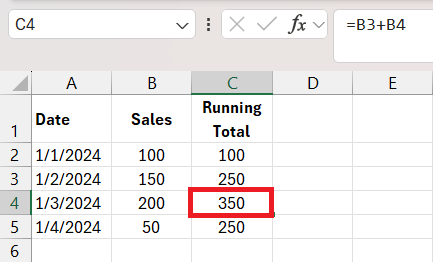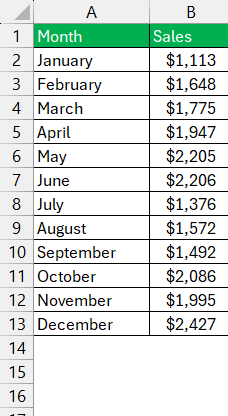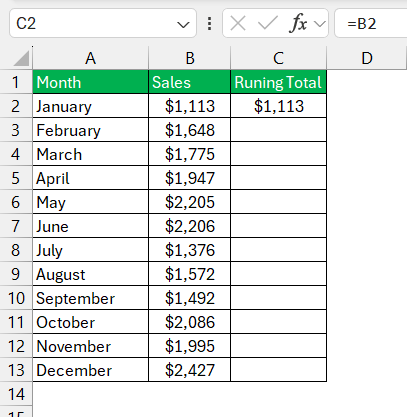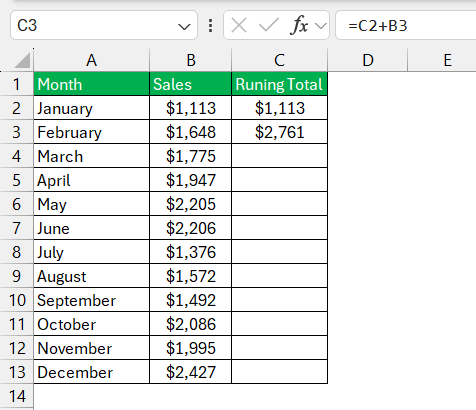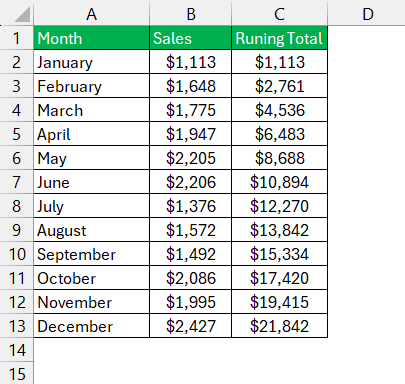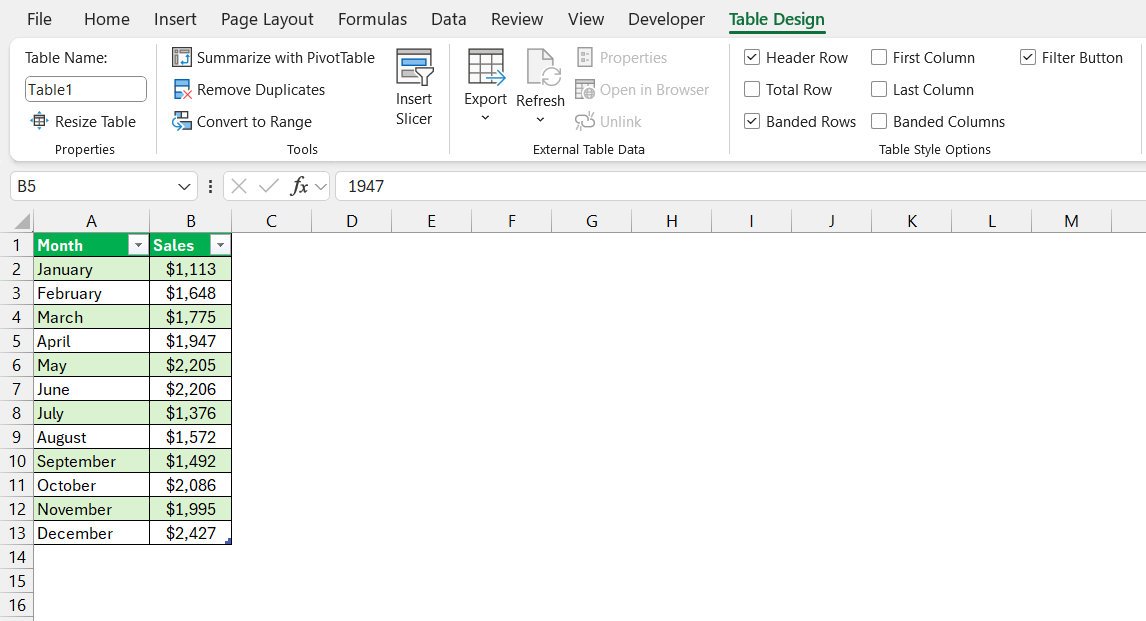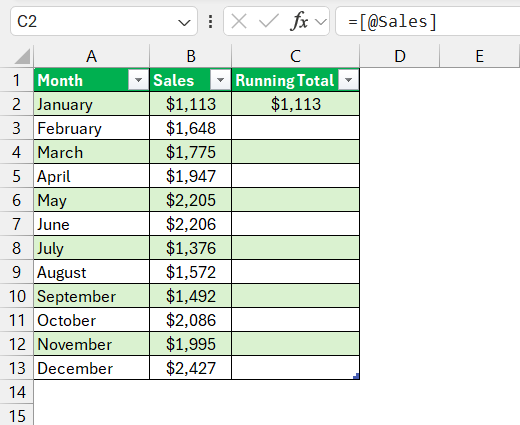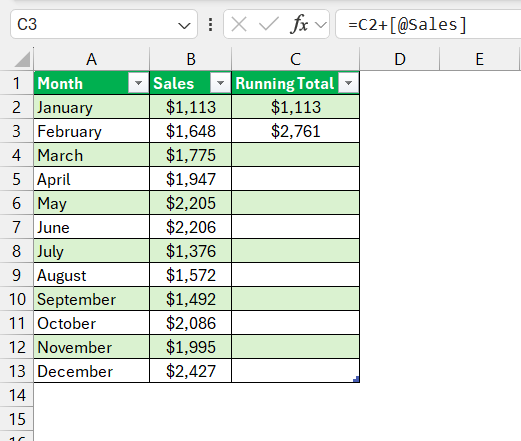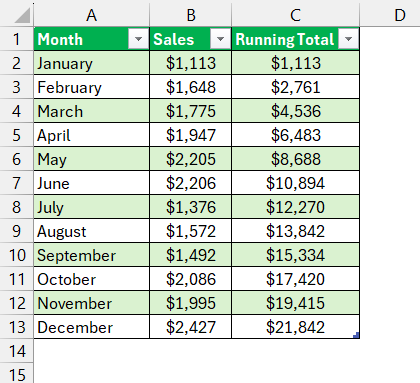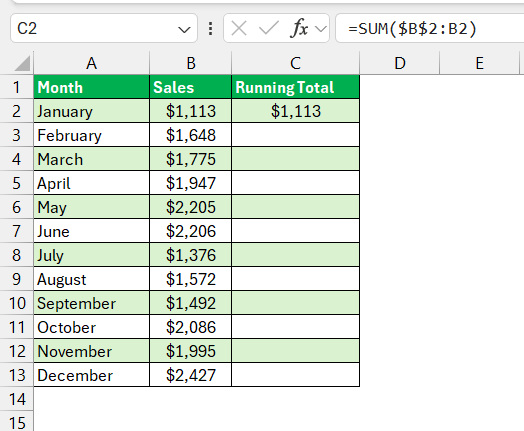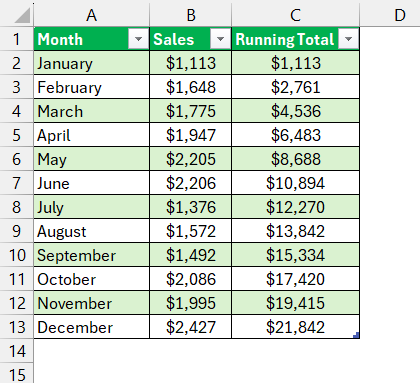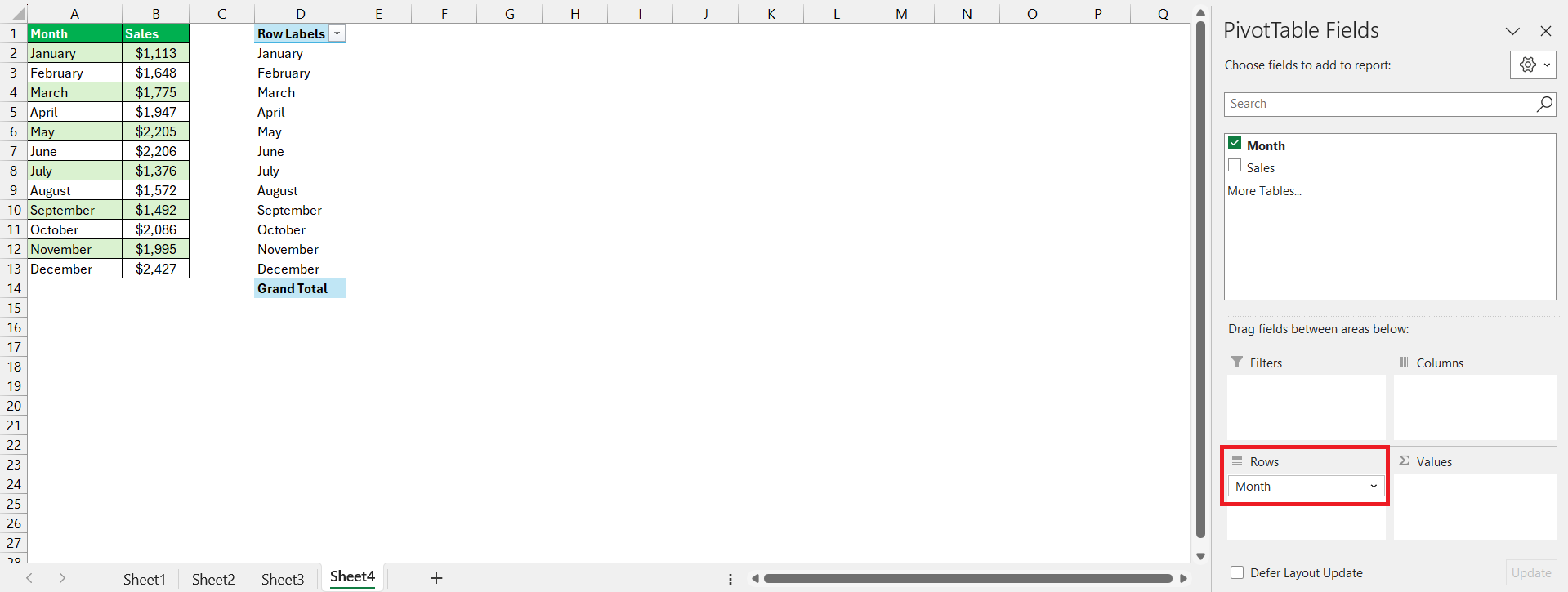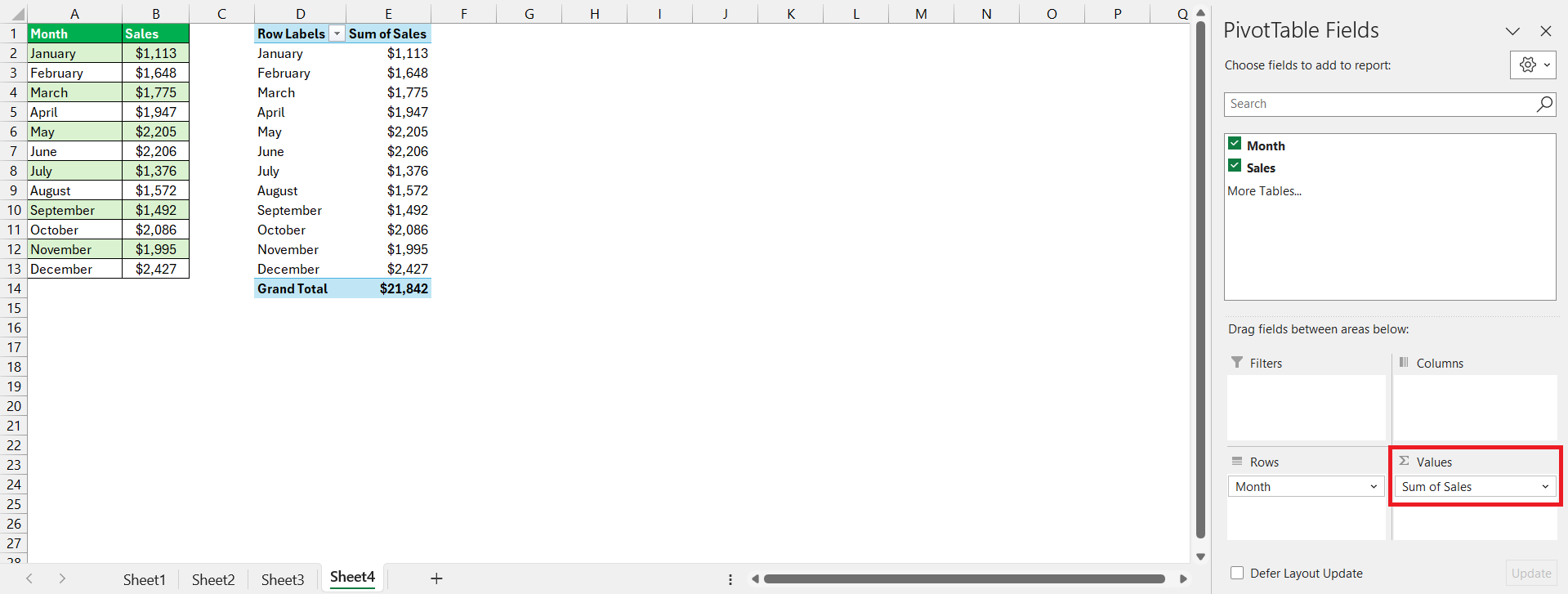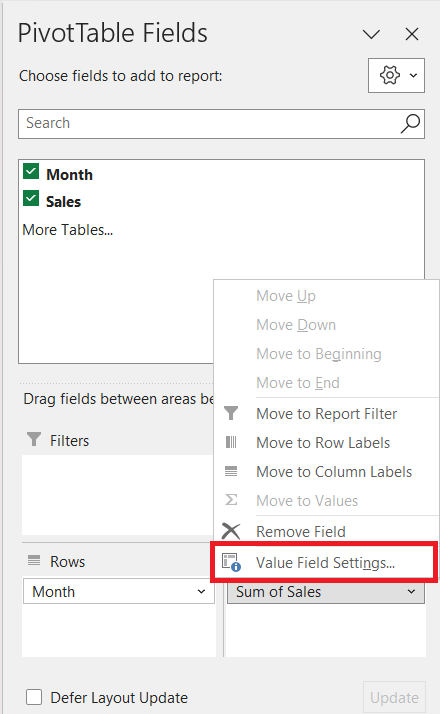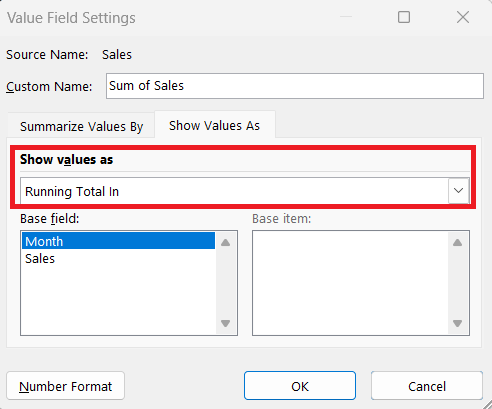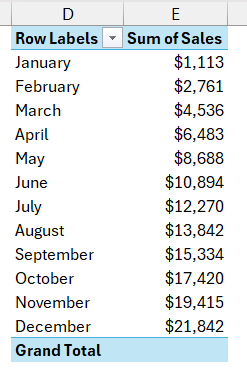A running total, or cumulative sum, is a great way to track how values accumulate over time. Whether it’s for monitoring expenses, sales, or any other sequential data, a running total helps me see how everything adds up at each step. In this article, I’ll walk you through several ways I use Excel to calculate running totals.
Key Takeaways:
- A running total in Excel accumulates values as new data is added, providing a cumulative sum.
- Running totals help professionals track growth or reduction over time for better decision-making.
- You can calculate a running total with simple addition formulas, Excel tables, or the SUM function with absolute references.
- Pivot tables are great for handling large datasets and calculating running totals efficiently.
- Running totals are practical for managing inventory and tracking budgets with year-to-date calculations.
Table of Contents
Introducing the Art of Running Totals in Excel
What is a Running Total?
In Excel, a running total is a form of calculation that provides ongoing summation of numbers as they are entered sequentially. Imagine each new entry being added to the tally of all the previous entries, giving us a cumulative sum.
This technique is essential in providing a dynamic view of how totals evolve over time, making it particularly valuable in various analytical contexts.
Excel Professionals Rely on Running Totals
Excel professionals count on running totals for their ability to convey continuous growth or reduction in datasets over time. This method serves as a key aid in decision-making, planning, and performance tracking.
The running total’s instant reflection of accumulated data helps present trends and patterns that are pivotal in forecasting and strategic analysis. It becomes especially powerful when making quick business decisions, where the most up-to-date financial picture is needed.
Methods to Calculate Running Total
Simple Addition Formula
STEP 1: First, make sure the data is in a neat table. Let’s say column A has dates, and column B holds monthly sales amounts.
STEP 2: In the first row of my running total column (for example, cell C2), I enter the same value from column B:
=B2
STEP 3: In the second row (C3), I add the value from the previous running total to the current day’s sales:
=C2 + B3
STEP 4: Copy the formula down the column by dragging the fill handle, so Excel adds each new row’s value to the previous running total.
This gives me a running total that updates as new values are added.
- C2: This just mirrors the first value in column B.
- C3 and onward: Each row adds a new value to the cumulative total.
This method is perfect when I’m dealing with a simple, straightforward list of numbers.
Using Excel Tables for a Dynamic Running Total
I use Excel tables when I need my running total to adjust automatically as I add or remove data.
STEP 1: Select my data and press Ctrl + T to turn it into a table. This ensures that formulas and formatting will update automatically as the table changes.
STEP 2: In the first cell of the running total column, enter this formula:
=[@[Sales]]
STEP 3: In the second row of the running total column, enter:
=[@[Sales]] + C2
STEP 4: Drag this formula down, and Excel applies it automatically to any new rows I add.
Using the SUM Function with Absolute References
I also like using the SUM function with absolute references to create a flexible running total, especially when I know I might insert or delete rows.
STEP 1: In the first row of my running total column (C2), I enter:
=SUM($B$2:B2)
STEP 2: Then, I drag this formula down for all the rows.
The $B$2 reference is absolute, meaning it always points to the first value in the column. The second part of the range, however, adjusts as I move down the rows. For example:
C2: =SUM($B$2:B2)
C3: =SUM($B$2:B3)
C4: =SUM($B$2:B4)
Using Pivot Tables for Large Datasets
When I’m working with larger datasets, pivot tables make calculating a running total much easier. This is especially useful for summarizing data while still keeping a running tally.
STEP 1: Drag my Month field to the Rows area.
STEP 2: Drag the Sales field to the Values area.
STEP 3: Click on the Sales field in the Values area, then select Value Field Settings.
STEP 4: From the Show Values As dropdown, I choose Running Total In and base it on the Date field.
The running total will be displayed.
Practical Applications of Running Totals
Streamlining Inventory Management with Running Totals
Implementing running totals within inventory management can radically streamline operations. By keeping a real-time tab on stock levels with running totals, businesses ensure accuracy, avoid overstocking or stockouts, and optimize their inventory turnover rates.
Excel makes it possible to track this data by subtracting sales from your starting inventory automatically. This kind of inventory monitoring is especially beneficial for small businesses or those with fast-moving products. It serves as an early-warning system, indicating when to reorder or slow down purchases, thereby enabling smarter, data-driven inventory decisions.
Effective Budget Tracking Using Year-to-Date Calculations
Year-to-Date (YTD) calculations stand out as a premier application of running totals, especially in budget tracking. By using the running total to sum up expenses or profits from the start of the financial year, we stay abreast of our financial health.
Businesses leverage this to review if they are within budgets and make necessary adjustments before deviations become problematic. The clarity gained from a YTD perspective informs forecasting and strategic planning. For personal finance, it is equally vital, offering a transparent view of where finances stand against annual goals.
FAQs About Running Totals in Excel
How do I do a running total in Excel?
To create a running total in Excel, start by entering your data in a column or row. Then, in the cell adjacent to your first data point, type the formula to sum the values up to that point. For subsequent cells, write a formula that adds the current data value to the previous total. Auto-fill this formula down the column or across the row to continue the running total.
What is the difference between SUM and running total in Excel?
The SUM function in Excel adds up a range of cells or individual numbers and presents a single sum. A running total, on the other hand, uses successive SUM calculations to add each new value to the previous subtotal, giving you a series of progressive totals. While SUM provides a static result, a running total evolves with each new data point, offering a time-based accumulation of values.
How Do I Start Creating a Running Total in Excel?
To initiate a running total, organize your data sequentially. Enter =A2 (assuming A2 is your first data cell) into the cell where you want your running total to begin. For the next cell below, enter =B2+A3 (B2 being the previous running total and A3 the next data point). Drag this formula down to calculate the running total for the entire data set as it grows.
Can Running Totals be Automated Across Different Sheets?
Absolutely. Running totals can span across different sheets in Excel. You’ll set up a formula that references the cell containing the last total on the previous sheet and adds it to the first item on the current sheet. Continue this total by adding each subsequent item to the running total. This can be automated further by naming your total cells and referencing these names in formulas for clarity and maintenance ease.
What Are Some Common Errors to Avoid When Working with Running Totals?
When working with running totals, common errors to watch for include incorrect cell references, not accounting for blank cells, and mismatched cell formats (numbers formatted as text). Ensure your range of cells expands or updates to include new data as it’s added—dynamic named ranges or Excel tables can help with this. Also, be cautious of manual entry errors or broken formulas which can disrupt the accuracy of your running totals.
John Michaloudis is a former accountant and finance analyst at General Electric, a Microsoft MVP since 2020, an Amazon #1 bestselling author of 4 Microsoft Excel books and teacher of Microsoft Excel & Office over at his flagship MyExcelOnline Academy Online Course.

